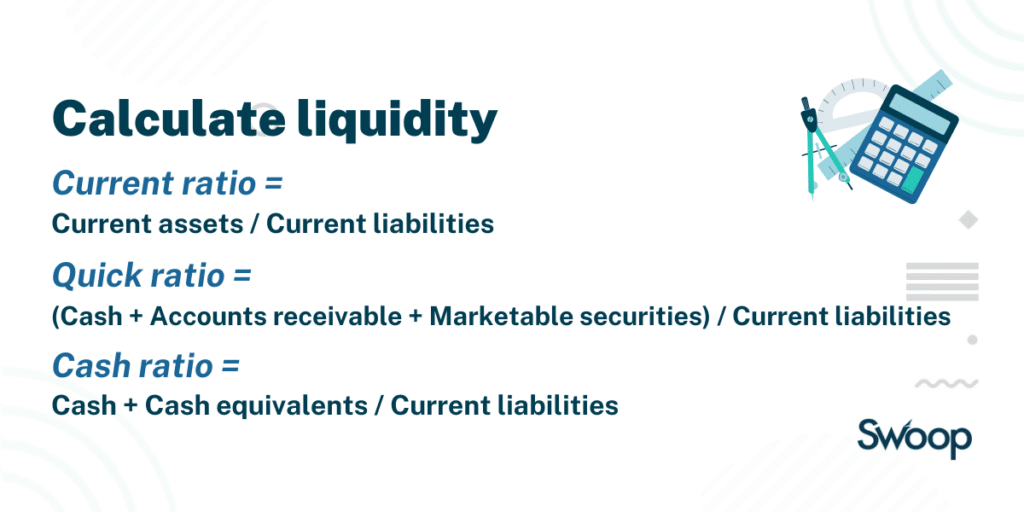Liquidity is an important term to understand if you run a business. Liquidity is a company’s ability to convert assets into cash to pay off its short-term obligations or liabilities – those that will become due in less than a year.
This guide explains all you need to know about measuring a company’s liquidity, including the different types of liquidity ratio.
What are liquidity ratios?
A liquidity ratio is a calculation used to measure a company’s ability to pay off any short-term debt obligations using its current (or liquid) assets. It’s used to indicate whether the business can pay off its debt and business loans with the cash it has readily available, or whether it will need to raise additional capital to do so. It can also show how quickly the assets held can be turned into cash for the debt.
Why are liquidity ratios important?
Liquidity ratios are important because they can give you an indication of a business’s financial health. As mentioned above, your liquidity ratio tells you whether you will be able to repay your debts. This usually means that you have sufficient cash, bank deposits or assets that can be quickly converted to cash to pay your bills.
If you don’t have sufficient liquidity, it’s likely your business will run into financial difficulties.
Liquidity ratios are also important to both lenders and investors. Lenders will want to be sure your business has enough current assets to repay its debts, while investors will also look at liquidity ratios as part of an overall financial analysis. Generally, they will be looking for ratios of 2:1 or 3:1 as this indicates the company has plenty of room to pay its short-term bills and will still have working capital to continue operating.
Common types of liquidity ratios
There are a number of different types of liquidity ratios such as current ratio, quick ratio and cash ratio. These are explained below.

Current ratio
The current ratio is also known as the working capital ratio and indicates your ability to pay debts that are due within 12 months from your current assets. It’s the easiest calculation to understand.
Current ratio formula
The formula for calculating the current ratio is as follows:
Current ratio = current assets / current liabilities
For example, if you had current assets of £160,000 and current liabilities of £80,000, your current ratio would be 2:1. This means you’d be able to cover your liabilities. On the other hand, if the ratio was 1:1 or lower, you could struggle to pay off your debts and you’d need to find ways to increase liquidity.
Quick ratio
The quick ratio or ‘acid test ratio’ measures your ability to pay off your current liabilities with assets that can be converted into cash swiftly and without losing too much of their book value. While the current ratio uses all current assets, the quick ratio limits it to accounts receivable (money that clients owe you), marketable securities (assets that are easily traded on a public stock exchange) and cash in the bank.
Quick ratio formula
The formula for calculating the quick ratio is as follows:
Quick ratio = (cash + accounts receivable + marketable securities) / current liabilities
For example, if your cash, plus accounts receivable, plus marketable securities worked out to be £50 million and your current liabilities were £40 million, your quick ratio would be 1.25.
A good quick ratio would be 1.5:1.
Cash ratio
This is the ratio of your cash and cash equivalents to total liabilities. It gives you an indication of the health of your business and is also used by lenders to measure your ability to pay back your debt.
Cash ratio formula
The formula used to calculate the cash ratio is as follows:
Cash ratio = cash + cash equivalents / current liabilities
For example, if your cash plus cash equivalents was £800,000 and your current liabilities were £700,000, your ratio would be 1.14.
If the cash ratio is above 1, you have the ability to meet your current debts. Anything below this means you won’t be able to meet your current liabilities.
The relationship between liquidity and net working capital
Net working capital is another way to measure liquidity. To do this, you need to use the formula below:
Net working capital = current assets – current liabilities
Ideally, you want your net working capital to be growing consistently alongside your business. Sales and assets should be going up as this will increase net working capital. On the other hand, if your working capital is declining, this indicates a lack of liquidity.
The goal of working capital management is to ensure the company has sufficient funds that are easily accessible for day-to-day operations, while avoiding excess reserves that can be expensive and affect the business’ profitability and returns.

































 yet? Register here!
yet? Register here!